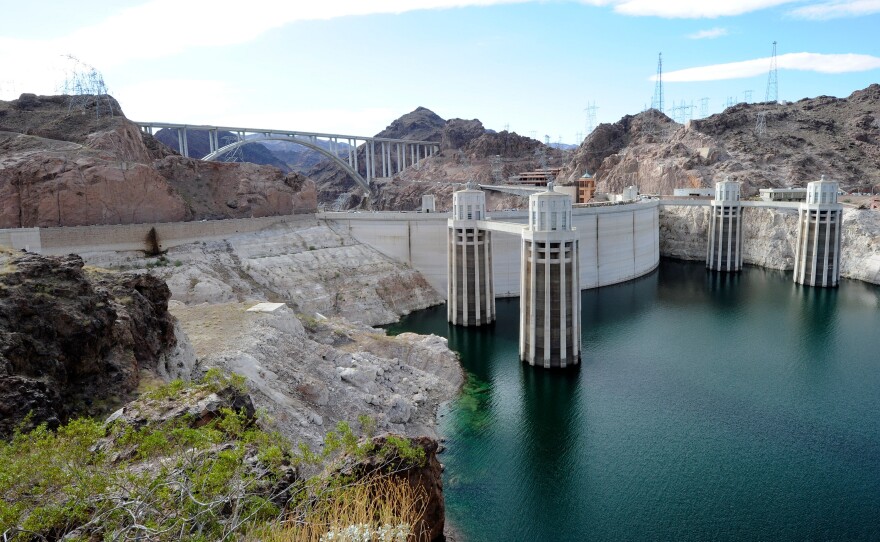This year, Hoover Dam celebrated its 75th anniversary. The giant dam near Las Vegas stores Colorado River water for much of the Southwestern U.S.
Its biggest customer is a small agricultural valley in the desert of southeast California, called Imperial Valley. About 400 farmers there have rights to nearly 70 percent of California’s share of the river to water their fields. But an unprecedented drought, and the looming effects of climate change, mean the farmers, and the dam they relied on, may be becoming relics of the past.
Farmers in Imperial valley have a long history, and an uncertain future. And The Osterkamp family is part of both.
“We’ve been farming here since 1947, and hopefully for a lot longer than that,” said Peter Osterkamp.
At 31, he’s the youngest farmer in his family. He’s doing everything he can to avoid being the last. His survival may depend, at least partly, on the water efficient sprinklers he installed recently
They’re spraying a very precise amount of water on a field of newly planted onions.
A few fields over, by the alfalfa, there’s a water recycling pump that captures irrigation run-off. He pointed to a meter on the pump that shows how much it’s conserved. It read 514 acre-feet. “That’s a lot of water,” he said.
Enough to fill the needs of about 1,000 households for a year. In fact, it’s households from nearby cities who are paying for this pump, in exchange for a bigger share of Colorado River water. To understand why, we need to go back 75 years, before the Ostercamp’s even got to this valley, when the Hoover Dam was built.
An educational film from the era gives a sense of the awe the dam inspired, proclaiming it “One of the biggest structures ever made...Part of the story of man, his conquest of rivers and his improvement of them for his own use!”
Conquest and improvement were indeed battle cries along the Colorado River back when Hoover dam was built to capture water for growing cities and make desert farms bloom.
There was just one problem -- the region was in the middle of the wettest period of the last millennium. Now drought, climate change, and more southwest suburbs than we ever imagined, mean the Colorado needs a new verb.
That verb is stretching, and it is high on the list of talking points for Doug Hendrix, spokesman for the U.S. Bureau of Reclamation, which built Hoover dam. As in stretching the water further. Stretching every drop. Stretching the river as far as possible.
Hendrix said these days, everyone along the Colorado River is retooling for water efficiency. And gone are the days of building mega-dams like Hoover. What the Bureau is building now is something you might call the “micro-dam.”
An example is a new project the Bureau supervised which is officially called the Warren H. Brock Storage Reservoir. Engineers know it by its distinctly unromantic nick-name, Drop 2.
It works like this, when the occasional rain storm hits the Valley, farmers draw less water from the Colorado River. In the old days, that leftover water just flowed down the river to Mexico. It was too little to matter. But these days, when every gallon counts, engineers are capturing it, at Drop 2. And that leaves more water in the system for cities.
The perfectly square man-made lake that is Drop 2 doesn’t seem quite to live up to the drama of Hoover dam, but to Andrea Ondreyco, a construction inspector for the Bureau of Reclamation, it is just as exciting.
“Bureau of reclamation has long time been known for its innovations in coming up with engineering solutions to the problems we face out there,” she said. And Drop 2 is the latest example.
But that’s just the problem, said Doug Kenney, head of the Western Water Policy Institute at the University of Colorado. “The solution to our water problems aren’t these engineering solutions,” he said.
Considering the long drought that’s hit the Colorado River Basin, and the dire predictions for climate change, even the most efficient technology won’t be able to support existing conditions in the Southwest.
“The supplies just aren’t getting any bigger, and in most places of the western US they’re likely to get significantly smaller,” Kenney said.
And so something big has to give. The Bureau of Reclamation is already contemplating drastic measures, like desalinating trillions of gallons of the Pacific, or piping water a thousand miles in from the Mississippi.
And then there are those onion fields in Imperial Valley. There are already fewer of them. In the last few years, the Bureau has pressured farmers to transfer millions of gallons of water to Los Angeles and San Diego. And in the process, fallowed thousands of acres each year.
“We want to be good stewards to the land and good neighbors with our urban partners, but there’s only so much blood you can get from a turnip,” said John Pierre Menvielle, a retired farmer who sits on the Imperial Irrigation District Board of Directors. He said it’s hard to fight cities’ political clout.
“They want to put restrictions on us, and how we grow our crops, and the amount of water we use here," Menvielle said. "Why isn’t someone putting restrictions on growth on the coastal plain, and their development?”
The question of who should get dibs on the dwindling water that runs through southeastern California won’t be solved by mega dams or micro dams or water efficient irrigation. Ultimately, it’s a question of priorities, and politics.





